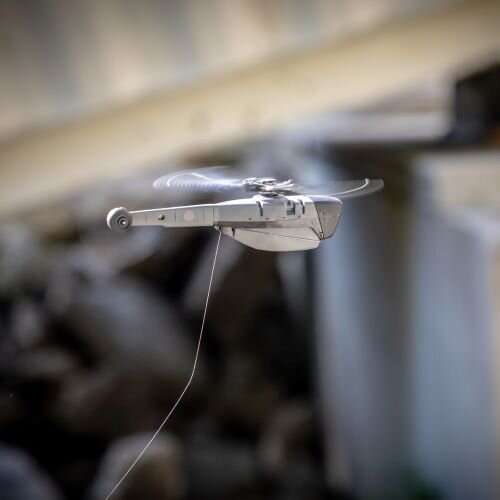Now you see it, now you don't: Adding chameleon-like capabilities to defense drones

In conjunction with the Department of Defense, University of South Australia material scientists have developed a range of lightweight panels that can change color on demand, allowing drones to match their appearance to the background colors of the sky.
Ever since the French had the bright idea of using hydrogen balloons for military surveillance in the late 18th century, aviation capability has played a central role in intelligence, surveillance and reconnaissance (ISR) operations.
Today unmanned aerial vehicles (UAVs), or drones, are a huge asset for ISR. The Australian Army has drones ranging from the tiny Black Hornet—which is about the size of a whiteboard marker—to larger models with wide ranging surveillance capabilities.
Despite their ubiquity and utility, however, all military UAVs are currently hindered by the same simple problem—the sky changes color, but they don't.
Given the huge importance of remaining undetected during ISR operations, the static color of drones can be a significant problem, but now, thanks to researchers at The University of South Australia's Future Industries Institute (FII), the solution is at hand.
In a collaboration with the Department of Defense, FII researchers, led by Dr. Kamil Zuber, have developed a range of lightweight polymer panels that can change color on demand.
The polymers are what are known as electrochromic materials, meaning they change color in response to an electric field, and the exact colors can be tuned to specific voltages.
"Similar technology has been used in luxury cars, for diming mirrors, and on the windows of the Boeing 787 Dreamliner," Dr. Zuber says.
"But those applications are slow, require high power consumption to switch, and the electric flow must be maintained to sustain the change state. Our panels, on the other hand, have switching speeds in the range of seconds and offer color memory, which means they retain their switched color without a continuously applied voltage. They also operate in the range from -1.5 to +1.5 volts, which means you only need to use an AA battery to activate the change."
In addition to their chameleon-like characteristics, the panels are inexpensive, lightweight and durable, and can be either rigid or flexible, making them ideal for use on drones of all sizes and specifications.
"We have built a small-scale frame of a UAV and put our panels on it. We have demonstrated it against all sorts of different sky states and completed a range of validation testing showing how these materials can respond in actual use," Dr. Zuber says.
"We have five or six different materials, and each of the materials can produce two to three distinct different colors."
The technology is currently being refined to integrate self-awareness and autonomous adjustment into the system, so drones will be able to automatically change color in response to changes in the surrounding environment.
"At this stage, we've been working mainly on the panels and the hardware, but during the latest stage of the project we've developed prototype electronics for the controller, which is something that could test the state of the sky and then automatically adjust the voltage to the panel to tune it to the right color. So, if the UAV passed in front of a cloud, it would turn pale, then when it moved back into blue sky, it would turn back to blue."
















